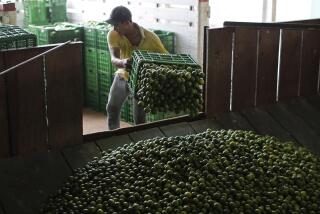Lemon Growers Bitter Over Sunkist Plan to Sell Imports
A decision by Sunkist Growers, the country’s largest citrus cooperative, to market imported lemons from Argentina has soured relations with many of its 6,500 members in California and Arizona, especially those in Ventura County whose fruit would directly compete with the imports.
Sunkist’s decision marks the first time the Sherman Oaks-based co-op has ever put its label on foreign fruit. It follows the Department of Agriculture’s decision in June to allow growers in Argentina--the largest lemon producer in the world--to begin exporting their citrus to this country.
“It’s a very competitive marketplace,” said Michael Wooten, a spokesman for Sunkist. “If we didn’t market that fruit, someone else would.”
Sunkist plans to market 400,000 cases of lemons from San Miguel, Argentina’s largest citrus grower, and Citrusvil this year, with the first shipment arriving in Philadelphia in a couple of weeks. DNE World Fruit Sales, a Florida citrus company, also will distribute Argentine lemons.
Under USDA rules, the Argentine lemons would not be sold in citrus- producing states such as California until 2004.
Growers fear that Argentina’s massive lemon crop, which this year amounts to about about 25% of the world’s 4.2-million-ton crop, will flood the U.S. market, depressing prices and exposing their groves to new pests. Several California growers have filed a lawsuit against the USDA seeking to overturn the agreement.
Meanwhile, a separate assault on Argentine citrus is taking place on Capitol Hill, where an amendment by Sen. Barbara Boxer (D-Calif.) seeking an injunction against shipments of the fruit until more scientific studies can be done was unanimously approved by the Senate and is awaiting discussion in the House.
“The USDA’s decision was both arbitrary and capricious and it deviates from the criteria the agency had already established [for that country],” said Joel Nelsen of the U.S. Citrus Science Council, the coalition that filed the suit on behalf of growers.
When Argentine growers attempted to enter this market several years ago, Nelsen said, they were given a list of inspection and pest control methods required to eradicate fruit flies and other citrus disease that could be spread to U.S. growing areas. The new rule, he said, is not as complete as these guidelines were, and he and Boxer believe that more independent research is needed to determine risk.
Food industry trade groups caution that this additional roadblock to imports could set a dangerous precedent for other U.S. trading partners.
“It really contradicts everything we’re trying to do in the world,” said Len Condon, vice president at the American Meat Institute and a former U.S. trade official. “This is more or less the height of hypocrisy where we say the risk assessment has been done, but now we’re going to put up some kind of political constraint on letting these products in.”
Fernando Oris de Roa, chief executive of San Miguel, said he understands grower concerns, but “after a while I would snap out of it and try to understand that it is more important to direct their energies to a more correct commercial relationship than challenging the science.”
After all, he said, the U.S. uses these same procedures to export citrus to markets such as China.
The USDA is allowing shipments only from the four Argentine states it believes are free of disease and is phasing in shipments over four years.
Initially, fruit will be allowed into 34 states, expanding after two years to the 10 states that border citrus-growing areas, and by 2004 into this country’s five citrus-growing states: California, Florida, Arizona, Texas and Louisiana.
Growers claim that the USDA is bowing to the State Department, sacrificing the U.S citrus industry in exchange for the right to export other products such as pork. They also charge that it is part of an effort to control the black-market trade of pharmaceuticals in Argentina, pointing to a February trip to that country by Commerce Secretary William Daley to discuss patent protections for drug companies and other businesses.
U.S. trade officials could not be reached for comment, but state agricultural trade representatives said this kind of trade-off is par for the course.
“That’s unfortunately the way of these international trade agreements,” said Fred Klose, acting director of trade policy for the California Department of Food and Agriculture. “Each side has got to get [something.]”
Although much of the debate has centered on protecting U.S. crops from pests, Ventura County growers, whose season coincides with Argentina’s, acknowledge that they are just as scared of the added competition.
“Increased supply has a way of bringing down prices,” said Gary Stiles, who grows lemons on 45 acres near Oxnard. “And Argentina grows a lot of lemons. There’s an awful lot of people who don’t want this happen.”
*
Reuters was used in compiling this report.
(BEGIN TEXT OF INFOBOX / INFOGRAPHIC)
Leading in Lemons
Argentina is the No. 1 lemon-producing country in the world and exports about 15% of its citrus crop--but so far, none to the United States. Top lemon producers In thousands of metric tons Argentina: 1,050
Spain: 899
U.S.: 797
Top importers of Argentina’s lemons In metric tons Netherlands: 65,134
Russia: 33,158
Spain: 21,899
Framce” 17,679
Poland: 14,003
Source: USDA Foreign
Agricultural Service Researched by NONA YATES/Los Angeles Times
More to Read
Inside the business of entertainment
The Wide Shot brings you news, analysis and insights on everything from streaming wars to production — and what it all means for the future.
You may occasionally receive promotional content from the Los Angeles Times.










